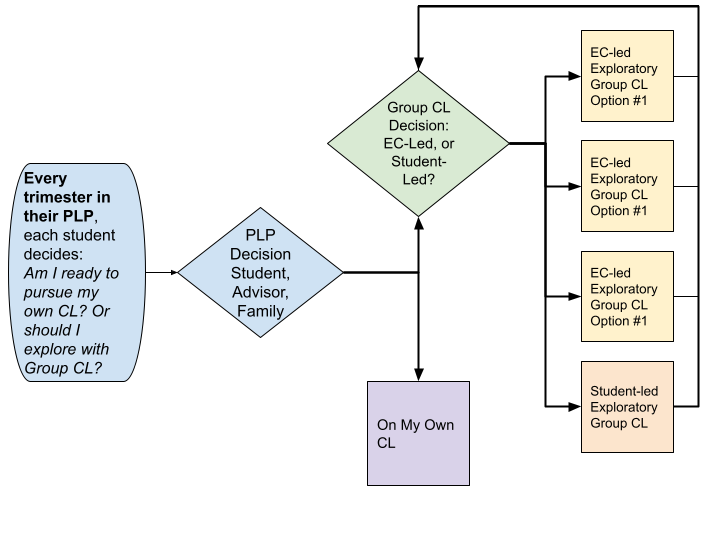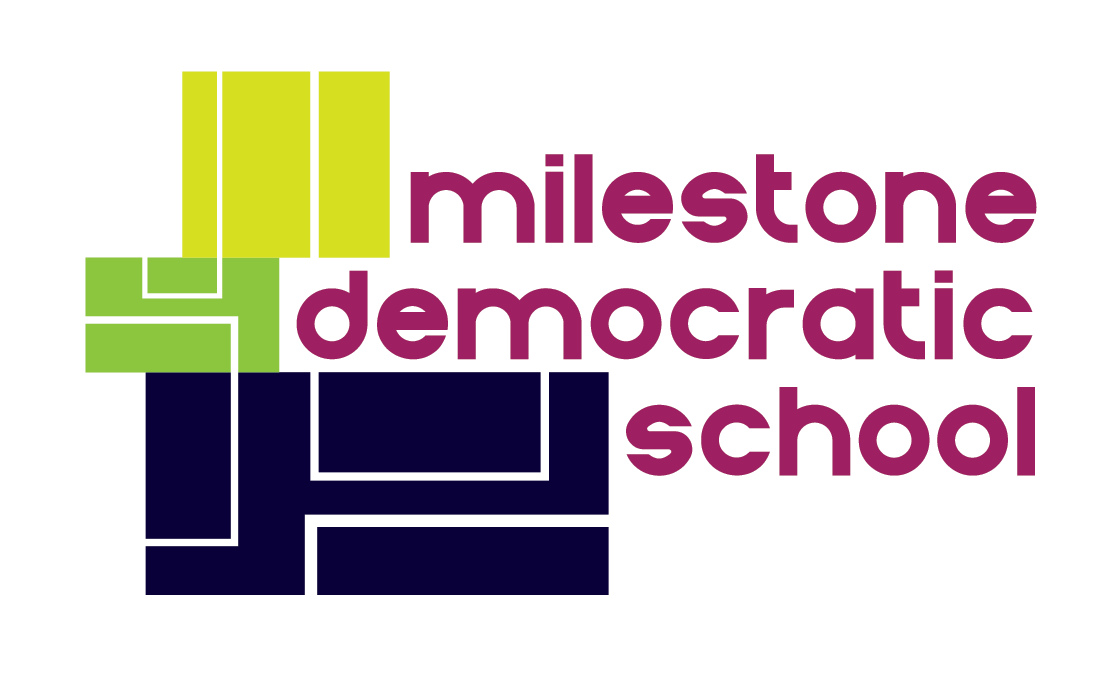
The process of scaffolding students into “On My Own” Community Learning
Personal Learning Plan (PLP) Decision
Every trimester, students are asked to make a decision when writing their PLP: am I ready to pursue Community Learning “On My Own”? In other words, do I feel prepared to pursue, arrange, and participate in an internship, apprenticeship, and/or long-term volunteer opportunity based on my own interests, passions, and values? Or, do I need to explore options first, participating in Group Community Learning?
Role of the Student
Students need to reflect honestly on their comfort and ability level – “am I ready?”
Role of the Advisor
Advisors need to help students make this first big decision, and to communicate with families leading up to the PLP conference if there is any uncertainty or concern. Honor and uplift student confidence – and also guide and direct as needed.
Role of the CL Coordinator
Be available to answer questions from students, families, and Advisors.
Group CL Decision: EC-Led or Student-Led
For students who choose exploratory Group CL, there is a second choice to make: do I want to participate in the Group CL options that the EC has planned, or do I want to form a group to pursue another idea?
Role of the Student
Students need to reflect honestly on their familiarity with the exploratory Group CL process – have they done at least one cycle before? If so, do they understand the process and feel ready to lead it themselves with a group of like-minded students?
Role of the Advisors / EC members facilitating Group CL
The EC members facilitating Group CL that trimester need to:
- Introduce the Group CL Learning Cycle: Group CL Learning Cycle
- Present the EC-Led exploratory Group CL options that are designed, planned, and ready to go
- Facilitate strategic grouping led with student interest but sensitive to relationships and group dynamics
Role of the CL Coordinator
Prepare theme-based options for EC-Led exploratory Group CLs. Each option should include:
- A central theme or concept that will be meaningful and interesting to students.
- A list of potential interviewees and guest speakers for the Group to review and select from
- A list of potential sites to visit. Sites should be:
- In line or easily connected to Milestone’s Worldview and Values
- Accessible by bus whenever possible
- Interactive whenever possible – trying to avoid simple “field trips” but instead finding sites where students can do something
- A list of potential “solidarity projects.” Project ideas should be:
- Connected to a community site or partner – ideally the site visited
- Utilize the Design Process to scaffold self-directed learning
EC-Led Exploratory Group CL Options
Role of the Student
Students should commit to seeing a cycle (Prepare —> Experience —> Reflect) all the way through once they pick one. Do your best work. Represent yourself and Milestone at your best.
Role of Advisors / EC Members Facilitating
Whether assigned to just one Group CL or to multiple (depending on group size, number of options, and student interest), the EC member facilitating needs to guide the group efficiently through the cycle. This includes:
Prepare with the Group
- Identifying, selecting, and providing readings at the appropriate skill levels that are connected to the theme and have a local community emphasis. Leading reading exercises and activities with the group to develop understandings. Especially emphasize readings about possible guest speakers and site visits.
- Identifying, selecting, and providing data sets and statistics to help the Group understand the theme and its impact on our communities more deeply. Lead data analysis exercises and activities.
- Facilitate student development of interview questions for guest speakers, and rehearse different interview techniques with students.
- Facilitate student outreach to guest speakers and site visit options, with support from the CL Coordinator.
Experience with the Group
- Participate in interviews with guest speakers (encouraging students to lead).
- Participate in site visits with students (again encouraging students to lead).
- Participate in the development of a solidarity project
- Develop ideas with the CL Coordinator: what can we as students and a school do to support, help, aid, and assist the important work of a community partner (ideally, the guest speaker and/or site visit)
- Facilitate the development and delivery of the solidarity project to the community partner.
Reflect with the Group
Facilitate group and individual reflection to help students document their experiences (for Exhibitions) and reflect on what they have learned.
Role of the CL Coordinator
Provide themes for groups to select. Provide logistical planning for interviews, site visits, and projects – is transportation needed? Do Google Meet links need to be created? Serve as the primary contact point for all community organizations and individuals that will be invited to participate in these experiences.
Update the ImBlaze database of CL opportunities with all site visits, guest speaker, and solidarity project recipients – use these Group opportunities to set the stage for future On My Own CLs.
Student-Led Group CL
A very similar experience as “EC-Led Group CL Options” – except students themselves form a group based on shared interests, and take on additional responsibilities of planning and logistics.
Role of the Student
Identify a theme or idea that is interesting to them, and find a group of like-minded students to form a group. Take on more responsibilities usually held by the EC Member facilitating Group CL and the CL Coordinator, including:
- Finding readings and data to analyze
- Developing your own interview process and questions
- Researching possible guest speakers
- Researching possible site visits
- Developing ideas for solidarity projects
Role of the Advisors / EC members facilitating Group CL
All duties described in “EC-Led Group CL Options” – except make an effort to transfer duties and responsibilities to the Group! Pay attention to how well they’re holding these responsibilities, and provide scaffolding and support as needed.
Role of the CL Coordinator
All duties described in “EC-Led Group CL Options” – except make an effort to transfer duties and responsibilities to the Group! Pay attention to how well they’re holding these responsibilities, and provide scaffolding and support as needed.
On My Own CL
Students reflect and prepare, then seek and obtain internships, apprenticeships, and/or long-term volunteer opportunities where they can develop meaningful learning experiences.
Role of the Student
Work at your own pace (being ready to be challenged and encouraged by your Advisor and other EC Members supporting you!) through the Individual CL Readiness Checklist
Role of the Advisors / EC members facilitating On My Own CL
Support, track, and respond to student needs as they work through their Checklist. All documents, prompts, and assignments are gathered in this folder: Individual CL – curriculum. Some activities work best when done in small groups, but all can be accomplished individually as students are ready for them.
Role of the CL Coordinator
Utilize ImBlaze (and provide training to students and Advisors on it when needed) to connect students with CL opportunities based on their interests. Serve as the primary contact-point for all CL partners in the community, using (or revising and using) the Letter to Hosts and Mentors – Community Learning Information. Proactively build a database of opportunities to present to students and Advisors as needed.
